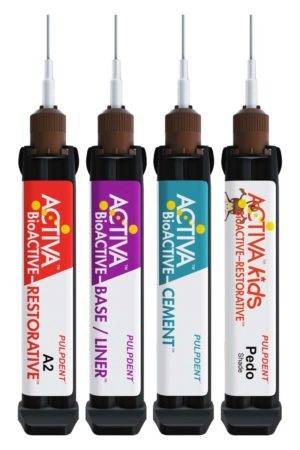Embrace™ WetBond™ Pit & Fissure Sealant
Embrace™ WetBond™ Pit & Fissure Sealant - Product Review
Fluoride Releasing • Light Cure • Wet Bonding • Radiopaque
Contains No Bisphenol A, No Bis-GMA, No BPA Derivatives
“It’s an absolutely sensational product!”
– John D. Doykos III, DMD, MSD
“Virtually undetectable margins”
– Dental Advisor 2004; 21(8)
“Bonds under adverse conditions.”
– Reality 2006
“[Sealants] looked the same as they did the day we placed them.”
– RDH 2006;26(7)
Embrace is the first pit and fissure sealant that bonds to the moist tooth. Research shows remarkable sealing ability and adaptation to tooth structure.1 The margins are undetectable, and the long-term success has been reported in the literature.2,3 Embrace releases and recharges phosphate and fluoride, and it has longer lasting antibacterial activity compared to other leading brands, especially against S. mutans.4,5
1) Kane B, Karren J, Garcia-Godoy C, Garcia-Godoy F, 2) Strassler HE, O’Donnell JP, Inside Dentistry 2008;4(9):108-110, 3) O’Donnell JP, Inside Dentistry 2008;4(7):50-52, 4, 2) Sharma S, Kugel G. IADR Annual Meeting 2008, 5) Naorungroj S, et al., J Dent 2010;38(5):387-391
Moisture Tolerant – Bonds in a moist field
- Wet-bonding resin technology
- Tooth integrating. Seals against microleakage
- Margin-free. No chipping. No staining
- Fewer steps. Saves time and money
- No drying or bonding agents required
- Available in off-white or natural shade
Exceptional Marginal Adaptation
Embrace resins form an intimate association with the moist tooth. They are tooth integrating, creating a margin-free interface between the resin and the tooth that eliminates microleakage.

Fig 1 SEM shows Embrace Pit & Fissure Sealant without bonding agent. Note the smooth margin and the extraordinary adaptation of the sealant to the tooth.
Fig 2 SEM shows leading competitor’s traditional pit and fissure sealant without bonding agent. Note the large gap between the sealant and the tooth.
* Kane B, Karren J, Garcia-Godoy C, Garcia-Godoy F.
Sealant adaptation and penetration into occlusal fissures. Am J Dent 2009;22(2):89-91.








